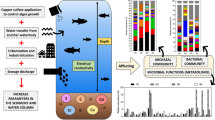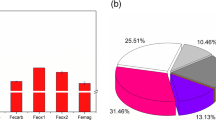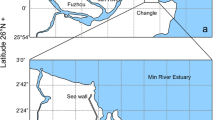Abstract
The Doñana National Park contains highly complex microbial communities that play critical roles in the bioavailability and biogeochemical cycling of elements. In this study, we analyzed the formation of Fe-rich films on the surface of shallow waters at Doñana National Park as a model for future applications in bioremediation. Phytoplankton composition and abundance, physicochemical measurements, culture enrichments, and molecular detection of microorganisms were determined during this study. Natural samples were incubated in the laboratory and enrichments producing similar phenomena were obtained. Bacteria belonging to the genera Enterobacter were the major participants in surface Fe-film formation in laboratory enrichments. Film formation was dependent on wind exposure and only those sites protected from the direct influence of wind developed these films. A higher concentration of euglenophytes was found in the proximity of film-covered waters. Available iron (Fe2+) and total Fe concentrations were high (18.8 and 46.6 mg/L, respectively) underneath the surface film, and higher than in film-free waters and pore-sediment water. The concentration of phosphate and its availability were higher in the iron-rich film sediment, as 61% of total P was bound to iron oxy-hydroxides. Our results provide evidence of the link between P and Fe biogeochemical cycling in aquatic systems on sandy soils at the Doñana National Park. In addition, they provide significant insights into the bioavailability of these elements with potential interest in the role of microorganisms for metal sequestration in natural environments and utilization in bioremediation processes.




Similar content being viewed by others
References
Altschul, S. F., Gish, W., Miller, W., Myers, E. W., & Lipman, D. J. (1990). Basic local alignment search tool. Journal of Molecular Biology, 215, 403–410.
Alvarez, S., & Guerrero, M. C. (2000). Enzymatic activities associated with decomposition of particulate organic matter in two shallow ponds. Soil Biology & Biogeochemistry, 32, 1941–1951.
Deutsche Sammlung von Mikroorganismen und Zellkulturen (DSMZ) (1989). Catalogue of strains 1989 (4th ed.). Braunschweig, Germany: Deutsche Sammlung von Mikroorganismen und Zellkulturen GMBH.
Díaz-Espejo, A., Serrano, L., & Toja, J. (1999). Changes in sediment phosphate composition of seasonal ponds during filling. Hydrobiologia, 392, 21–28.
Golterman, H. L. (2004). The chemistry of phosphate and nitrogen compounds in sediments. London: Kluwer Academic.
Gonzalez, J. M., Ortiz-Martinez, A., Gonzalez-delValle, M. A., Laiz, L., Saiz-Jimenez, C. (2003). An efficient strategy for screening large cloned libraries of amplified 16S rDNA sequences from complex environmental communities. Journal of Microbiological Methods, 55, 459–463.
Grimalt, J. O., Yruela, I., Sáiz-Jiménez, C., Toja, J., Leeuw, J.W., & Albaigés, J. (1991). Sedimentary lipid biogeochemistry of and hypertrophic alkaline lagoon. Geochim Cosmochim Acta, 55, 2555–2577.
Jauregui, J., Toja, J. (1993). Dinámica del fósforo en lagunas temporales del P. N. de Doñana. In L. Cruz-Pizarro, R. Morales-Baquero, P. Sánchez-Castillo, & P. Carrillo (Eds.), Actas VI Congreso Español de Limnología (pp. 99–106). Granada, Spain.
López, T., Toja, J., Gabellone, N. A. (1991). Limnological comparison of two peridunar ponds in the Doñana National Park (Spain). Arch Hydrobiol, 120, 357–378.
Muñoz-Reinoso, J. C. (2001). Vegetation changes and groundwater abstraction in SW Doñana, Spain. Journal of Hydrology, 242, 197–209.
Murphy, J., & Riley, J. P. (1962). A modified single solution method for the determination of soluble phosphate in natural waters. Analit Chem Acta, 27, 31–36.
Sacks, L. A., Herman, J. S., Konikow, L. F., & Vela, A. L. (1992). Seasonal dynamics of groundwater-lake interactions at Doñana National Park, Spain. Journal of Hydrology, 136, 123–154.
Serrano, L., Calzada-Bujak, I., & Toja, J. (2003). Variability of the sediment phosphate composition of a temporary pond (Doñana National Park, SW Spain). Hydrobiologia, 429, 159–169.
Serrano, L., Pérez-Romero, P., Plazuelo, A., Torres, A., & Toja, J. (2000). Microbial degradation of dissolved polyphenolic compounds in seasonal-ponds. Verh Int Verein Limnol, 27, 3252–3259.
Serrano, L., Reina, M., Martín, G., Reyes, I., Arechederra, A., León, D., & Toja, J. (2006). The aquatic systems of Doñana. Limnetica, 25, 11–32.
Siljeström, P., & Clemente, L.E. (1990). Geomorphology and soil evolution of a moving dune system in South-West Spain (Doñana National Park). Journal of Arid Environments, 18, 139–159.
Siljeström, P., Clemente, L., & Figueroa, M. E. (1987). Localización de zonas de surgencia del nivel freático a través del estudio edáfico. In Actas VII Reunión Asociación Española para el Estudio del Cuaternario (Aequa) (pp. 89–92). Santander, Spain.
Togwell A. J., & Bistricki, T. (1995). Selective scavenging of copper, zinc, lead, and arsenic by iron and manganese oxyhydroxide coatings on plankton in lake polluted with mine and smelter wastes: results of energy dispersive X-ray micro-analysis. Journal of Geochemical Explorations, 52, 97–125.
Utermöhl, H. (1958). Zur vervollkomnung der quantitativen phytoplankton-methodik. Mitt Int Ver Limnol, 9, 1–38.
Velasco, S., López-Archilla, A. I., Montes, C., & Guerrero, M. C. (2006). The functional role of the microbial community in the Almonte-Marisma´s aquifer system (Doñana, SW Spain). In Proceedings ASLO Meeting 2006. Victoria, BC, Canada).
Vollenweider, R. A. (1969). Primary production in aquatic systems. IBP Handbook 12. Oxford: Blackwell Scientific.
Williams, P., Biggs, J., Fox, G., Pascale, N., & Whitfield, M. (2001). History, origins and importance of temporary ponds. Freshwater Forum, 17, 7–15.
Acknowledgements
The authors acknowledge funding from the Spanish Ministry of Education and Science through project CGL2004-03927-C02-01/BOS.
Author information
Authors and Affiliations
Corresponding author
Rights and permissions
About this article
Cite this article
Portillo, M.C., Reina, M., Serrano, L. et al. Role of specific microbial communities in the bioavailability of iron in Doñana National Park. Environ Geochem Health 30, 165–170 (2008). https://doi.org/10.1007/s10653-008-9138-0
Received:
Accepted:
Published:
Issue Date:
DOI: https://doi.org/10.1007/s10653-008-9138-0




